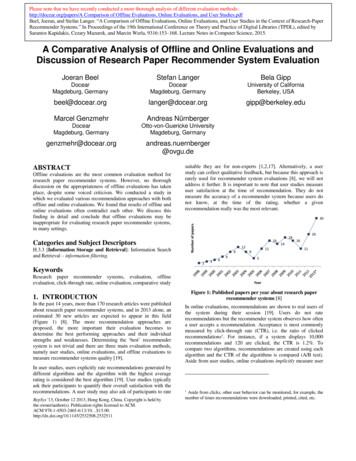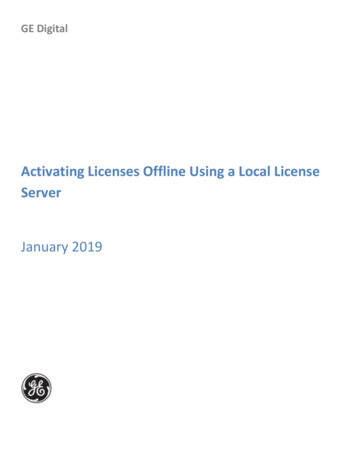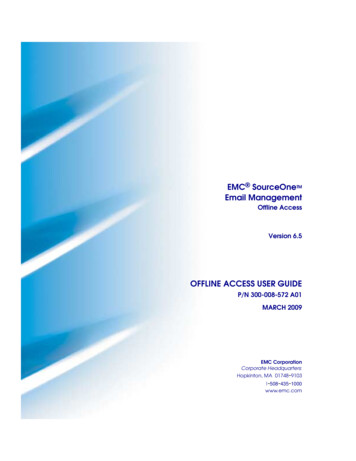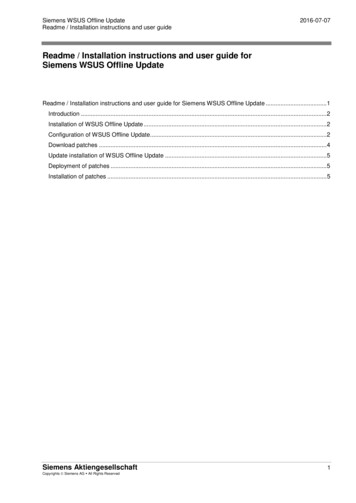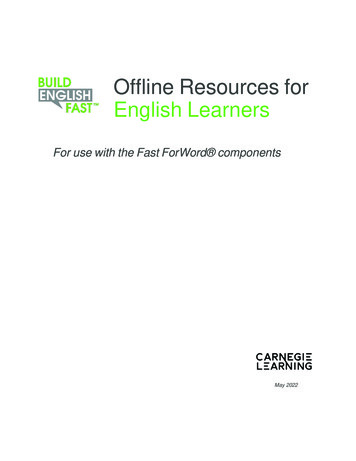
Transcription
Offline Resources forEnglish LearnersFor use with the Fast ForWord componentsMay 2022
Copyright 2022 Carnegie Learning Corporation. All rights reserved. This document is supplied subject to the terms ofthe Carnegie Learning Corporation license agreement. Information in this document is subject to changewithout notice. Names, data, and other information used in examples and exercises herein are fictitious.Portions of this product are 1985 Susan Curtiss and Jeni Yamada.TrademarksFast ForWord and SciLEARN are registered trademarks of Carnegie Learning Corporation, registered in theU.S. and certain other countries.MySciLEARN , Reading Assistant Plus , and Build English Fast are trademarks of Carnegie LearningCorporation.Third-party trademarksECHEVARRIA, JANA J.; VOGT, MARYELLEN J.; SHORT, DEBORAH J., MAKING CONTENTCOMPREHENSIBLE FOR ENGLISH LEARNERS: THE SIOP MODEL, 5th Ed., 2017. Reprinted by permissionof Pearson Education, Inc., New York, New York.Other brands and their products are trademarks of their respective holders. Trademark symbols are used onlyin the first occurrence of a trademarked name.Carnegie Learning CorporationCarnegie Learning Corporation401 Grant StreetUnion Trust Building, Suite 1075Pittsburgh, PA 15219888-851-7094www.carnegielearning.comCustomer SupportCustomer Support888-358-0212 (US & Canada)520-917-1200 (International)help@carnegielearning.com2
ContentsContents3About this guide5About the resources5What resources are provided?55566Which of the components have resources?Which students will benefit from the resources?Which staff members can use the resources?When should I use the resources?How to use the resourcesBest practices for the classroom67More resources81 Fast ForWord Foundations I9Foundations I - Introduction10Foundations I - Robo-Dog (1)13Foundations I - Robo-Dog (2)24Foundations I - Ele-Bot (1)33Foundations I - Ele-Bot (2)40Foundations I - Space Commander472 Fast ForWord Foundations II52Foundations II - Paint Match53Foundations II - Polar Planet57Foundations II - Tomb Trek62Foundations II - Cosmic Reader (1)67Foundations II - Cosmic Reader (2)90Foundations II - Cosmic Reader (3)1123 Fast ForWord Elements I135Elements I - Introduction136Elements I - AI Assistant (1)139Elements I - AI Assistant (2)1464 Fast ForWord Elements II154Elements II - Cinematch (1)1553
ContentsElements II - Cinematch (2)166Elements II - Cinematch (3)177Elements II - Cinematch (4)191Elements II - Illuminator202Elements II - Mission Control212Elements II - PicFlip2175 Fast ForWord Reading Level 1223Reading Level 1 - Bear Bags224Reading Level 1 – Magic Rabbit .232Reading Level 1 - Quail Mail240Reading Level 1 - Bedtime Beasties247Reading Level 1 - Buzz Fly2626 Fast ForWord Reading Level 2272Reading Level 2 - Bear Bags More LunchReading Level 2 - Magic Bird273Reading Level 2 - Leaping LizardsReading Level 2 - Ant Antics293299Reading Level 2 - Dog Bone3107 Fast ForWord Reading Level 3Reading Level 3 - Book MonkeysReading Level 3 – Chicken Dog (1)Reading Level 3 – Chicken Dog (2)Reading Level 3 - Scrap Cat282324325336344352Reading Level 3 - Twisted Pictures (1)359Reading Level 3 - Twisted Pictures (2)3708 Fast ForWord Reading Comprehension375Reading Comprehension - Cognobot376Reading Comprehension - Print Shop384Reading Comprehension - Road Trip3894
About this guideAbout this guideAbout the resourcesThe Fast ForWord components provide a solid base for students to learn about and practice the Englishlanguage. However, students who are not familiar with English idioms, cultural references, and vocabulary mayhave a few extra hurdles when learning the English language. With this in mind, Scientific Learning hasdeveloped a set of English Learner offline resources to supplement the Fast ForWord components.What resources are provided?The offline resources include individual, leveled lessons for the Fast ForWord components that providetargeted instruction for English Learners. The lessons are based on the SIOP Model, with addeddifferentiation for the Fast ForWord exercises. Many of the lessons provide writing tasks, including work withgraphic organizers (for example, diagrams, tables, concept webs).Which of the components have resources?Most of the Fast ForWord component exercises have resources, while the few exercises that focus on soundsor nonsense words do not. Those exercises can be supported through classroom instruction in earlyliteracy/pre-literacy skills, which is not exclusive to English Learners. Some of the longer and more complexexercises have multiple lessons.Reading Readiness does not have resources, as it teaches early literacy skills such as phoneme/graphemeidentification and onset-rime. If your student is having challenges with the exercises in Reading Readiness,you can try using typical early literacy classroom instructional practices.Tip: You can use the Fast ForWord English learner resources with the Foundations and Elementscomponents.Which students will benefit from the resources?The offline resources were written with English Learners in mind but are certainly not limited to those students.Feel free use them with any Fast ForWord student that might benefit from a little extra practice. For example: Students who are new to our product Students receiving intervention alerts in the reports Students classified as pre-emergent, emergent, beginning, developing, expanding, or bridging in Englishlanguage Students being considered or progress-monitored for special educations services Students receiving services for special education, speech language pathology, or occupational therapy5
About this guideWhich staff members can use the resources?The offline resources were designed for these instructors, but any qualified instructor can use the offlineresources with their Fast ForWord students. For example: General education classroom teachers ELS teachers or ELL coordinators Special educators Speech language pathologists Occupational therapists School social workers or psychologistsWhen should I use the resources?The offline resources are appropriate for any of these environments: Readers Workshop Writers Workshop Guided Reading ESL pullouts ELD/English Language Development blocks Intervention blocks Special education classes Occupational therapy sessions School psychologist/social worker sessions (with IEP or parent and administrator approval)How to use the resourcesThe lessons can be incorporated into your instruction in a variety of ways. While each lesson is written for a 10to-30-minute mini-lesson or class session, you can adapt the lessons as needed to meet your student orscheduling needs.Each lesson includes the following components: Standards. Lists the “Can Do Descriptors” for the lesson, taken directly from the WIDA standardsframework.Targeted English Language Proficiency. Lists the WIDA language proficiency levels targeted in thelesson: Entering, Emerging, Developing, Expanding, Bridging, and/or Reaching. Objectives. Provides the goals of the lesson, specifically language and content objectives. Key Vocabulary. Identifies important vocabulary words. Materials. Lists the items needed for the lesson. Motivation. Provides a context for the lesson. Presentation. Includes the actual lesson content to be presented to your students. Practice/Application. Outlines group or individual activities designed to reinforce the presentation content.6
About this guide Review/Assessment. Includes prompts for getting your students started on the product.ELD Differentiation (Fast ForWord only). Provides scaffolds at the language proficiency levels of thelesson. The differentiation is not part of the SIOP model but is included to help you adapt the lessons asneeded. For example, if you feel that a student may not be adequately challenged by a lesson, you can usethe differentiation to help you craft a modified lesson plan for that student.Extension. Provides extra activities to further challenge students.Throughout the lesson you’ll see specific instructions for you (in plain text) and for your students (in bold text, tobe read aloud to your students). The student instruction scripts are written in a casual tone to reflect aclassroom environment. Here’s an example:Learning new words is something good readers do to help understand stories. Why is it important tounderstand what we read? Give students time to think and respond.You may also notice some text in parentheses at the top of a section. The authors of SIOP include thesefamiliar research-based terms to help you identify those sections.Best practices for the classroomResearch shows the efficacy of providing native language support across the four language domains (reading,writing, listening, speaking), and we recommend using it where applicable and available.In addition, the following supports can help boost student success, both with our product and in your classroominstruction. Feel free to incorporate and adapt these strategies as you see fit. Create word walls/cognate walls in your classroom Incorporate visuals and/or realia (real life objects) into your lessons Provide explicit vocabulary instruction Try some Total Physical Response (TPR) activities Preview essential learnings and key vocabulary from the product Expand your use of language scaffolding based on the techniques provided in the lessons or from otherresourcesCelebrate student success by incorporating classroom motivation systems for using the product7
More resourcesMore resourcesMySciLEARN provides several methods for getting help.MySciLEARN ResourcesMySciLEARN Resources provides access to all training information, including teacher materials, videotutorials, and staff training (The Academy). Access it from htm.SupportIf you need further assistance or have more questions, contact Carnegie Learning Customer Support.Customer SupportWeb & ailsupport@scilearn.comPhone1-888-358-0212 (US & Canada)1-520-917-1200 (International)HoursMonday - Friday 6 AM - 5 PM PT8
1 Fast ForWord Foundations I1Fast ForWord Foundations IThis chapter includes the offline lessons for the Foundations I component.What's in this chapterFoundations I - Introduction10Foundations I - Robo-Dog (1)13Foundations I - Robo-Dog (2)24Foundations I - Ele-Bot (1)33Foundations I - Ele-Bot (2)42Foundations I - Space Commander519
Lesson Topic: Foundations ILESSON TOPIC: Foundations IS TA N D A R DSWIDA Grade Level Clusters 3-5, 6-8Reading:Use context clues and illustrations to determine meaning of words/phrases.Use L1 to support L2.Listening:Follow multi-step oral directions.Complete content-related tasks or assignments based on oral discourse.Categorize content-based examples from oral directions.Speaking:Describe pictures, events, objects, or people using phrases or short sentences.Discuss stories, issues, and concepts.Ask for clarification (e.g., self-monitor).TA R GET ED EN GLI S H LA N GU A G E P R O FI C I EN C YEntering, Emerging, DevelopingO BJ E C T I V E SLANGUAGE – Students will be able to listen to and comprehend basic directions in Fast ForWord Foundations I usingteacher support, key words, and modeling.CONTENT – Students will be able to have some understanding of the commands and terminology used in each ofthe programs through teacher modeling and exploring on their own.KEY VOCABULARYSpace CommanderEle-BotSky GymkeyboardmousebuttonsHoop Nutcomputer screenWhalien MatchMoon RanchRobo-Doglog inwebsite 2022 Carnegie Learning, Inc. All rights reserved.1
Lesson Topic: Foundations IMATE RIALS Flash cards or printouts of the names of the Foundations I exercises (with characters if possible) Flash cards or word wall with key words listed with visual examples Computer for teacher and computers for each student with working headphones and an internet connection Printed and enlarged initial screens for each of the exercises, preferably in color (print your screen while viewingthe exercise demos, check the Fast ForWord user manuals or help, or project the initial screen from yourcomputer) Student logins for the Fast ForWord programMOTIVATION(Building Background)The Fast ForWord Foundations I program can be used with students who are at various stages of English languagelearning. This introductory activity can be adapted to fit any of the Foundations I exercises, but it is critical to do itBEFORE students start the exercises on the computer, especially if they have little or no English knowledge.Today we will explore a new program called Fast ForWord Foundations I. Thisprogram will help us with reading, speaking, listening, and writing in English.The skills we’ll learn in this program will help us become strong readers in English. Whyshould we get better at reading in English?Give students wait time to respond (10-25 seconds), or Think-Pair-Share their responses for more in-depth responses.Follow along with me and then we will explore together. When we finish you will have sometime to explore on your own.PRE SE NTATION(Language and Content Objectives, Comprehensible Input, Strategies, Interaction, Feedback)Look at the screen here. What do you see?Give students wait time to respond (10-25 seconds).What do you think I do here?Have students Think-Pair-Share responses.Let’s take a look.Model the activity for students, describing aloud what’s happening on the screen. 2022 Carnegie Learning, Inc. All rights reserved.2
Lesson Topic: Foundations IIntroduce or review some key vocabulary about computers here where appropriate. Now is a good time to introduceclassroom and individual goal setting for each activity. If you want to build additional buy-in, have students come upwith a class story about each character and why they are doing what they are doing. See if you can set a goal aroundeach exercise for the class.Show only one or two exercises for each mini-lesson.ELD Dif ferent iat io nEntering, Emerging: Introduce the lesson and model the activity in students’ native language where possible. Ifthat’s not doable, as in the case of a group of students that speak several different languages, use key words in yourdescriptions written on the board. Point or direct students to repeat those words as you do the action in the product.Give students time to process your words and actions by moving slowly and speaking intentionally (withoutoverenunciating). Anticipate areas where students might get confused in the lesson and provide key vocabulary toexplain any potentially confusing parts of the exercise.Developing, Expanding: Before modeling, have students guess what the student does with each exercise. Ask someguiding questions about what students should do for each exercise and what each exercise teaches to get studentsthinking before modeling the exercise. Encourage students to get creative with their guesses.Spend less time modeling, having students participate along with you as soon as you see them understanding theexercise. Build in some time at the end of the lesson to allow students to talk about the challenges and fun they hadwith the exercise.PRAC TIC E /APPL IC ATION(Guided Practice, Interaction, Strategies, Feedback)Now let’s practice some together. Using your login information, log in on the computer infront of you. You will need headphones soon, but not yet. When you finish logging in, touchyour nose to let me know you are ready to continue (or some other command that worksfor you).Have students do the first part of the exercise with you. Answer any questions they have and clarify any potentiallyconfusing steps.RE VIE W/ASSE SSME NT(Review Objectives with Vocabulary, Assess Learning)Have students continue working on the Fast ForWord program until their time is up.E XTE NSION1. If students quickly get the hang of an exercise and there is time, introduce another. 2022 Carnegie Learning, Inc. All rights reserved.3
Lesson Topic: Robo Dog (Lesson 1)LESSON TOPIC: Robo-Dog (Lesson 1)S TA N D A R DSWIDA Grade Level Clusters 3-5, 6-8Reading:Use L1 to support L2 (e.g., cognates).Use bilingual dictionaries and glossaries/Use English dictionaries and glossaries.Writing:Draw content-related pictures.Fill in graphic organizers, charts, and tables.Listening:Follow multi-step oral commands/instructions.Use learning strategies described orally.Speaking:Ask for clarification (e.g., self-monitor).Explain and compare content-based concepts.TA R GET ED EN GLI S H LA N GU A G E P R O FI C I EN C YEntering, EmergingO BJ E C T I V E SLANGUAGE – Students will be able to listen to, say, read, and write new words in English using a Frayer Model.CONTENT – Students will be able to use new vocabulary in a Frayer Model to comprehend the words in the RoboDog exercise in Fast ForWord Foundations IKEY VOCABULARYRobo-Dog word list (page 7)MATERIALS Flash cards or printouts of the Robo-Dog words (select 15-25 for this lesson) Whiteboard and markers Spanish/English dictionaries Frayer Model graphic organizer (page 6) Whiteboard or clearly visible surface for writing Student logins for the Fast ForWord program 2022 Carnegie Learning, Inc. All rights reserved.,1
Lesson Topic: Robo Dog (Lesson 1)MOTIVATION(Building Background)Emergent bilinguals need exposure to the Robo-Dog vocabulary before using Robo-Dog.Before playing Robo-Dog today, we need to practice some new words in English. You will seethese words in Robo-Dog. Let’s say Robo-Dog.Everyone practices saying Robo-DogLearning these words will not only help you in Robo-Dog, but will build yourvocabulary in English. You will be able to use these words in speaking, listening,reading, and writing.That way your English development continues to grow. We need to grow our English so thatwe can become proficient readers.Why do you think we should be proficient readers? What does being a reader help us do?Give students wait time to respond (10-25 seconds). Have students Think-Pair-Share responses for more thought outanswers.Now it’s time to learn some new words. This sheet will help us learn them. This sheet iscalled a Frayer Model [pronounced FRAY-er]. Let’s say that together.Write “Frayer Model” on the board/somewhere clearly visible. Show students a blank Frayer Model graphic organizer.PRE SE NTATION(Language and Content Objectives, Comprehensible Input, Strategies, Interaction, Feedback)We will walk through the different parts of the Frayer Model and then we will do onetogether. To start, we write our new word in the middle box. Today’s first new word is“bee.”Model writing “bee” in the center box.What is a bee?Give students a minute to come up with some words to describe a bee. Show a picture of a bee. If “bee” is too easy,select a word from the higher tiered Robo-Dog word list.We will write that definition here. Let’s say ‘definition’ together.Point to the word “definition” on the page in the first box.A definition is what a word means. We learn it by reading in a dictionary (hold updictionary) or coming up with a definition. Can someone tell us what a bee is? 2022 Carnegie Learning, Inc. All rights reserved.,2
Lesson Topic: Robo Dog (Lesson 1)Give students some time to describe “bee.” Have students Think-Pair-Share their ideas to get thoughts and wordsflowing. If they do not have the words, feel free to introduce your own words or a short definition. Give students anopportunity to clearly hear you and understand.So here, we write ‘A bug with six legs and yellow and black stripes. It stings. It makes honey.’Write whatever definition students create.For younger students, you can simply give a short definition and have them write it. Model writing the definition. Forolder students, model using the dictionary by looking up the word and reading the definition aloud. For more of achallenge, have students practice paraphrasing the definition to write in the first box.Now we come to the second box. In the second box we need a picture.Point to the label at the top of the box that says “Picture.”Let’s draw a bee. What does a bee look like?Have students use words to describe a bee and then take 2-3 minutes to draw. Model drawing the bee with students.For older students or students who are proficient writers, you can simply have students write a sentence in Englishusing the word “bee.” The label on the second box can read “Sentence” rather than “Picture” (or both).Now, in the third box it asks us for an example.Point to the word “example” on the page.We need an example of a bee. What is an example of a kind of bee?If students can’t think of a kind of bee, offer bumble bee or honey bee, maybe even a famous character who is a bee,etc.Let’s draw that example here.Model drawing the example the students come up with. Again for older students or for students who like a challenge,have them write the words (for example, “honey bee”) rather than draw the picture.A non-example is something that a bee is not. What is not a bee? This can be anythingthat is not a bee.Have students come up with something that is not a bee—you and me, other insects, etc.Let’s draw that here.Model drawing the non-example, again taking just a few minutes. 2022 Carnegie Learning, Inc. All rights reserved.,3
Lesson Topic: Robo Dog (Lesson 1)PRAC TIC E /APPL IC ATION(Guided Practice, Interaction, Strategies, Feedback)Now that we all know what to do, it’s your turn to practice learning new words with thisFrayer Model. Using this word list, pick two more words to learn today. Complete a FrayerModel for both of those words. You can use your brain, a partner, the dictionary, or me (theteacher) to help you come up with a definition for each word.Hold off on using the dictionary for younger learners. For more independent or older students, have them use thedictionary.We have 10 minutes for 2 more Frayer Models (add or subtract the number of FrayerModels students can complete in the given time frame as needed).ELD Dif ferent iat io nEntering, Emerging: If the words in the Robo-Dog word list are difficult for students to identify, have students picktheir own words from somewhere in the classroom. This gives students an opportunity to practice the concept of aFrayer Model without the pressure of working with unfamiliar words. Once students are familiar with the process of aFrayer Model, have them move on to unknown words from the word list.Developing, Expanding: To challenge students, have them complete Frayer Models on words that are not nouns.Allow students to choose their word(s) and get them approved by the teacher before beginning working. Havestudents construct sentences with their new words on the back of their Frayer Models.Make this task more challenging by using more difficult prompts on the Frayer Model, in place of those that comeeasily to students. For example, in place of a picture or a sentence with the word, have students write a story of 3-5sentences related to the word, such as a fairy tale or an origin story myth of how it came to be. Other examples:What does this word make you think of?, What is a synonym/antonym of this word? What is this word in a differentlanguage?RE VIE W/ASSE SSME NT(Review Objectives with Vocabulary, Assess Learning)Now let’s take a couple of minutes to talk about the new words we learned. What canyou tell us about your new words?Have students share what new words they learned (about 3-5 minutes).Now that we have learned all these new words, it’s time to practice them in Fast ForWord.Today you will practice Robo-Dog. Let’s log in and begin working in Robo-Dog.Have students work on the Fast ForWrd program until their time is up. 2022 Carnegie Learning, Inc. All rights reserved.,4
Lesson Topic: Robo Dog (Lesson 1)E XTE NSION1. For older students, select the Robo-Dog word list or a group of words that fit the instructional need of yourstudents. For more challenging words the content specific vocabulary is a good challenge, for beginninglanguage learners or younger students, select a different group of words.2. If students easily pass through the Frayer Model with the word list you start with, begin the next session withhigher-tiered words.3. If students want more, have them complete more than 1 or 2 Frayer Models.4. Alternatively, have them practice writing sentences with the new words, practice saying those sentences with apartner, and pair with a partner to come up with a story about one or more of the words and write it out.5. Have students use a dictionary to come up with sentences for the words they choose. Have them write a storyincorporating their new words. 2022 Carnegie Learning, Inc. All rights reserved.,5
Lesson Topic: Robo Dog (Lesson 1)Supplementa l Material : Frayer Mode l graphic organizer 2022 Carnegie Learning, Inc. All rights reserved.,6
Lesson Topic: Robo Dog (Lesson 1)Supplementa l Material : Word list 2022 Carnegie Learning, Inc. All rights reserved.7
Lesson Topic: Robo Dog (Lesson 1)Supplementa l Material : Word list 2022 Carnegie Learning, Inc. All rights reserved.8
Lesson Topic: Robo Dog (Lesson 1)Supplementa l Material : Word list 2022 Carnegie Learning, Inc. All rights reserved.9
Lesson Topic: Robo Dog (Lesson 1)Supplementa l Material : Word list 2022 Carnegie Learning, Inc. All rights reserved.10
Lesson Topic: Robo Dog (Lesson 1)Supplementa l Material : Word list 2022 Carnegie Learning, Inc. All rights reserved.11
Lesson Topic: Robo-Dog (Lesson 2)LESSON TOPIC: Robo-Dog (Lesson 2)S TA N D A R DSWIDA Grade Level Clusters 3-5, 6-8Listening:Complete content-related tasks or assignments based on oral discourse.Apply learning strategies to new situations.Follow multi-step oral directions.Speaking:Communicate in social situations.Repeat words, short phrases, memorized chunks.Describe pictures, events, objects, or people using phrases or short sentences.Ask for clarification (e.g., self-monitor).TA R GET ED EN GLI S H LA N GU A G E P R O FI C I EN C YEmerging, Developing, ExpandingO BJ E C T I V E SLANGUAGE – Students will be able to listen to, say, read, and write new words in English using a game called “Is ittrue?!”CONTENT – Students will be able to use sentences about pictures to comprehend the words in theRobo-Dog exercise in Fast ForWord Foundations I.KEY VOCABULARYRobo-Dog word list (page 5)MATERIALS Flash cards or printouts of the Robo-Dog pictures (select 20-30 for this lesson) Other images from other sources Whiteboard or other writing surface clearly visible to students Student logins for the Fast ForWord program 2022 Carnegie Learning, Inc. All rights reserved.1
Lesson Topic: Robo-Dog (Lesson 2)MOTIVATION(Building Background)Emergent bilinguals need exposure to the Robo-Dog vocabulary before using Robo-Dog.Before playing Robo-Dog today, we are going to play a little game. This game will help youunderstand the directions in Robo-Dog. Let’s say ‘Robo-Dog.’Everyone practices saying Robo-Dog.Learning these directions will not only help you in Robo-Dog but will build yourvocabulary in English. You will be able to use these words in speaking, listening, reading,and writing. That way your English development continues to grow.PRE SE NTATION(Language and Content Objectives, Comprehensible Input, Strategies, Interaction, Feedback)The game we’ll play today is called ‘Is It True!?’ Let’s say that together: Is It True.Now, true means real. False means not true, or not correct. What does ‘true’ mean?Give students wait time to respond (10-25 seconds).What does ‘false’ mean?Give students wait time to respond (10-25 seconds).For example, if I say, ‘the sky is blue,’ is that true or false?Give students wait time to respond.Now, what if I say, ‘the sky is green?’ Is that true or false?Give students wait time to respond. Explain the concept of true and false in students’ native language if needed.What are some other things that are true? What are some things that are false?Give students time to form statements of things that are true and false (use frames below if needed).Theis.Pandas areI likeI don’t likeTwo plus two is. 2022 Carnegie Learning, Inc. All rights reserved.2
Lesson Topic: Robo-Dog (Lesson 2)Show students a picture from the Robo-Dog word list and make a few simple statements about the picture orobject. Model the student role of deciding whether your statement was true or false. Use native language supportas needed. Write key words from your question on a whiteboard or similar surface for students to see as you ask thequestion to give students added support in understanding your question. Alternatively, articulate the question inEnglish, in students’ native language, and again in English for a different kind of scaffold.PRAC TIC E /APPL IC ATION(Guided Practice, Interaction, Strategies, Feedback)Play the student role along with students and gradually have students take over the student role. For addedchallenge, have students articulate why the statement is true or false. As students get comfortable with the activityand if it is appropriate, break off students into pairs and have them make statements with their own set of cards toplay Is It True!? with a partner.ELD Dif ferent iat io nEntering, Emerging: It’s OK if students’ English production is minimal. Allow students time to formulate ideas andprovide sentence stems for the game, building off of the sentence frames from earlier or creating your own as you goalong. For example:I see.There is.There are.One thing I can see is.This picture has.Two things in this picture are. It lookslike.is one thing I can find.is something I can see.What is happening in this picture is.What is not happening here is.It doesn’t look like. 2022 Carnegie Learning, Inc. All rights reserved.3
Lesson Topic: Robo-Dog (Lesson 2)Developing, Expanding: Have students play the game using different pictures, and challenge students to increasethe difficulty in their statements. Model varied sentence structures to add complexity students can
About this guide 7 Review/Assessment. Includes prompts for getting your students started on the product. ELD Differentiation (Fast ForWord only)
